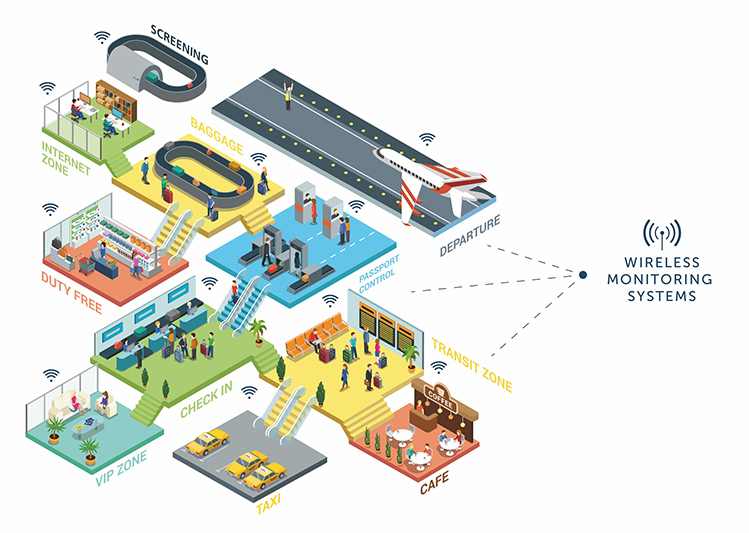Operational breakage, technical failures, growing legislative demands, human error, as the list of challenges facing the operational rigor of airports across the globe grows larger, what does this mean for the future of core airport functions that drive the daily routines?
At this very moment in time, airports around the world are facing excruciating challenges in highly intense times for the aviation and logistics sectors.
Population growth across the globe as well as the enhanced diversity of consumer trends has resulted in more people travelling internationally than ever before, with a further 35% increase expected by 2025. These behavioural changes create new challenges, adding to the demand on aviation operators.
Examples of consumer driven change include the likes of Airbnb; contributing to a more attractive and accessible travel solution for those on a budget, and with an increased population looking to fly quicker and cheaper, airport operators are being squeezed; with reduced profits and demand for a better, quicker and a more secure service.
With the evolution of technology, solutions to these problems; from threatened profits, increase in demand and the need for additional investment in operational infrastructure, are key to future-proofing operational rigor and the subsequent consumer experience.
Alleviating these challenges could be the answer to not only sustaining, but enhancing airport performance, accelerating efficiency, safety and productivity.
Today, the need to implement and align technological advances into operational infrastructure to maximise airport output is greater than ever before.
Technology has sat at the heart of, and revolutionised consumer experiences for the past 30 years, however, as airlines and the infrastructure that serve them become increasingly reliant on technology, vulnerabilities become clearer and minor technical failures can cause catastrophic outcomes.
Insufficient investment in technology infrastructure over the past decade has resulted in a spate of technical outages that have crippled an airline’s operations for days on end. Over the past couple of years, airlines have experienced major disruptions caused by anything from electrical fires to security breaches, faulty equipment and more.

What can be done to help future-proof airport productivity?
Create a smarter airport. Picture this; every single piece of mechanical hardware monitored for faults before they become faulty. Every room monitored for the slightest temperature changes to report real-time fire risks. Every electrical and mechanical item fixed before they become broken. All without a single wire in sight.
Advancements in technology now means that airports can retrieve second by second data through the application of Cyber Physical Systems. The advent of such technology has begun to revolutionise airports and distribution facilities, with the addition of a new product innovation in the form of remote wireless monitoring.
The remote wireless monitoring of electromechanical equipment across the airport engineering infrastructure and associated facilities can be used to monitor any part of an airport, including shops, passenger flows and enable early warning signs of failures to processes and equipment.
With real-time reporting and the ability to centralise data on cloud-based servers, information can be accessed, assets monitored, and issues raised from anywhere at any time, avoiding lengthy delays in solving infrastructure failures, and most importantly, highlighting these issues ahead of breakage.
With over 70 different types of sensors on the market, the monitoring possibilities are endless. Live monitoring will help airports reduce maintenance cycles with real-time data feeds to custom built dashboards informing risk managers, engineers and senior team members of any impending failures.
Furthermore, Artificial Intelligence (AI) now allows systems to pick up trends within specific assets, learning from past data to understand estimated breakage points and peak fluctuation times, providing a greater window of opportunity for corrective action.
Importantly, technologies such as these provide transparency from the ground-up, supplying the relevant information to the right people, across any device, as and when needed. This means that engineers receive immediate data on concerned assets ultimately leading to greater efficiencies and up-time of any and all monitored hardware.
What next?
The implementation of intelligent technologies has for a long time been the differentiator between failure and success for large operations, and as artificial intelligence technologies grow smarter with the rate of technological advancement, the next decade will prove to be the most exciting yet.
The future of aviation, logistics and all supporting operations is well and truly in the hands of those open to change, open to implementing smart technologies and subsequently creating a data driven, technologically focused, intelligent business of the future.
Think about the changes you can implement today to enhance the way you work tomorrow. Maintain that mindset, implement change and today’s operation will be tomorrow’s success.
Contact:
Colin Smith
Chief Executive Officer
CHS Engineering Services Ltd
colin_smith@chsservices.com







